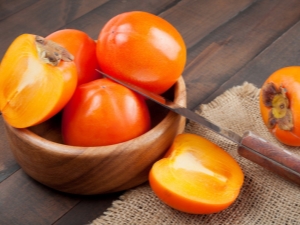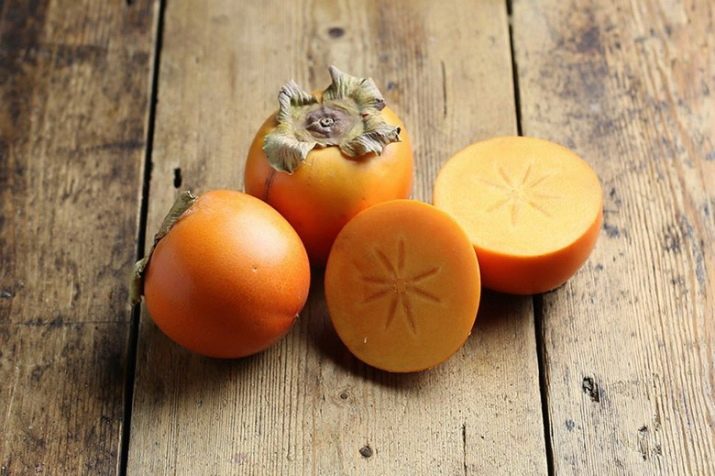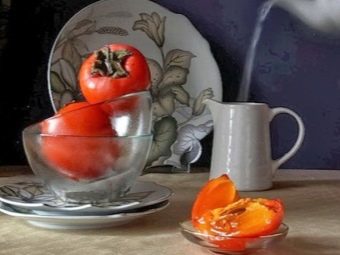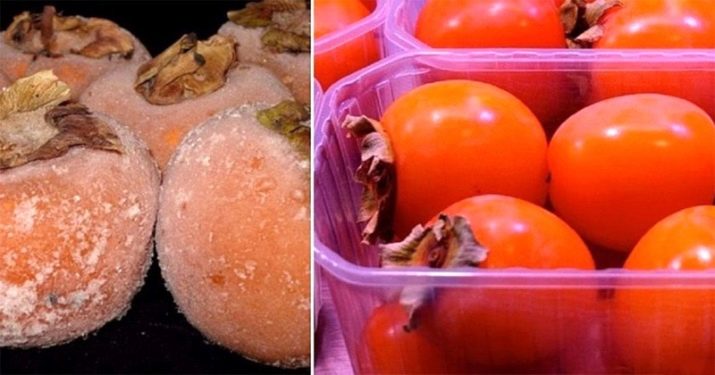Why persimmon knits: the causes and solution

In late autumn and early winter, ripened seasonal fruits appear on the counters of shops, which are used to decorate the New Year's table. Pomegranates and figs, tangerines and oranges, quinces and grapes.Among this vitamin splendor, you can find another fruit that has gained popularity among Russian consumers. This is a bright orange persimmon berry.
Special features
Persimmon has an unusual sweet-tart taste, juicy flesh and a lot of vitamins. But because of some of its features berry rarely falls on the holiday table. First of all, it is not a presentable kind of ripe fruit and the knitting properties of the pulp, from which the oral cavity becomes numb. To this should be added the high price of the product and the possible consequences for the body if this fruit is abused.
First, let's look at the causes of the viscous effect of persimmon.
The reasons
According to the knitting properties of the berry, you can determine the degree of its maturity. The fact is that in the process of ripening in the pulp of this fruit contains a large amount of tannin, which has a tanning effect. The mucous membrane of the mouth reacts to tannin by reducing the secretion of saliva, coagulation of proteins and vasoconstriction, which causes the effect of viscosity.
Tannin is a medicinal substance that is widely used in pharmacology. Products rich in tannin are black and green tea, pomegranate, grapes and wines, cognacs, nuts, spices, beans and chocolate derived from it.
But if in these products the light knitting effect only enhances and emphasizes their taste, then they say about persimmon that it knits the mouth. Viscosity manifests itself so strongly that it causes discomfort, numbness of the oral cavity, and if used excessively, interruptions in intestinal motility. But as the berry matures, tannin loses its tanning properties, and the fruit ceases to have a knitting effect, bringing only benefit to the body.
How to choose
Persimmon fruits are among those products that should not be chosen for their beautiful appearance. A fully ripe berry is soft and tender, easily wrinkled from touch, has unattractive brownish patches on the skin and a dark fruit stem. It is extremely difficult to transport it, so the fruit comes to the shelves most often immature. So, it has an astringent effect.
Exceptions are the varieties of "King", "Sharon" and "Royal". They differ in appearance from their fellows and do not bite their mouths, while retaining all the healthy and taste properties of ordinary persimmon.
"King"
This is the fruit of the usual persimmon, the flowers of which were pollinated. To make the persimmon sweet and non-astringent, the agronomists resort to artificial pollination of the inflorescences, as a result of which another kind of berry is obtained. The Kinglet has a characteristic orange color, a dark peduncle and brown rings diverging from it. The skin of such fruits, although soft, is rather elastic, the flesh is brownish, contains small bones.
"Sharon"
This variety is a hybrid of persimmon and apple, characterized by larger spherical fruits. Sharon, bright and attractive in appearance, remains dense and elastic even in overripe form. Pulp at a grade light, without stones. When choosing, one should be careful, as there is a risk to acquire the immature fruits of common persimmon, confusing it with the variety "Sharon".
"Royal"
Persimmon has the shape of a cone and truly royal size. In its mature form, it retains a bright beautiful appearance and an elastic form. This berry is not ashamed to decorate the fruit plate on the holiday table. To give the “Royal” persimmon the best taste, let the berries soak for a few days at room temperature. Then the fruits will go into the juice, and the delicacy will turn out excellent.
Treatment
If you are “lucky enough” to purchase the immature fruits of persimmon, do not rush to get upset about the wasted considerable money. There are several effective ways to eliminate the viscosity of these wonderful berries at home.
Frost
The fastest way, with the help of which after a few hours the berries will get a ripe sweet taste without signs of astringency.You should put the persimmon in the freezer for 2-3 hours to allow it to freeze completely. After that, the berries are left to thaw at room temperature. However, in the process of freezing the berries lose not only the properties of tannins, but also some of the vitamins, and also take on an unattractive appearance after defrosting.
Heat treatment
Adherents of this method recommend pouring hot water up to 50 degrees with berries. Maintain berries should be 2-3 hours, periodically changing the water as it cools. Under the influence of temperature, the tannin begins to break down, the flesh loses viscosity, and the fruit itself becomes sweeter.
Natural ripening
In this way it is accepted to bring tomatoes and apples to maturity. Fruits are individually laid out on a bright warm place, preferably a window sill, and left to ripen for several days.
Storage
In a ripe form persimmon can not be stored for a long time. After full maturity, it quickly turns into a stage of decay and decay. That is why ripe berries can be found on sale only in the late autumn and early winter. The optimal time frame for purchasing persimmon is October-November.
Despite the fact that persimmon is a seasonal fruit, it is possible to preserve tasty and healthy berries for up to six months. They are frozen in the freezer, pre-packaged in separate portions or individually. This is done in order not to have to thaw the entire crop.
After defrosting, the fruit should be eaten immediately, as their shelf life will already be calculated in a few hours.
Persimmon well retains its beneficial properties and processed dried. However, this method is more likely for those cases when there are too many fruits and you can put them on dried fruits. Fruits are cut into round slices and spread on a baking sheet. The oven is heated to 45 degrees and dried persimmon for 6-8 hours. Thus, sweet slices of dried persimmon are obtained, which can be stored for up to four months.
Benefits and contraindications
In addition to tannin, which has antioxidant properties and helps to strengthen the walls of blood vessels, persimmon contains a large amount of vitamins and minerals. In terms of the amount of vitamin C and potassium, persimmon is not inferior to citrus, and iron and iodine, some varieties of this fruit contain slightly less than apples and sea kale. Persimmon is rich in vitamins E, PP, B group and beta-carotene.
Another useful property of persimmon is a large amount of fiber - insoluble fibers that clean the intestinal walls. Due to this property, persimmon is successfully used in the fight against obesity.
However, excessive consumption of persimmon can cause serious harm to the body. Tannins can reduce intestinal motility, and indigestible fibers form lumps on this background - bezoars, which leads to unpleasant sensations, colic and constipation.
Persimmon is contraindicated for diabetics and people suffering from diseases of the gastrointestinal tract.
Tips and tricks
Experts give some tips on how to properly store and eat persimmon for food. Let us examine the most significant of them.
- Persimmon ripen faster if you put the unripe berries in a transparent glass container or plastic bag together with ripe fruit - apple, banana, pear. The container or bag should be hermetically sealed so that the gas released by the ripe fruit does not evaporate, but acts on the persimmon. After about a day, the persimmon will acquire ripeness and unique flavoring notes of the neighboring fruits.
- Numbness of the oral cavity under the influence of persimmon can be quite unpleasant and even painful, especially for young children. To quickly eliminate this phenomenon, it is enough to do a rinse with a weak solution of soda or salt. Particles of substances will collect the molecules of tannin, after which they can be easily removed from the tongue with a teaspoon or a toothbrush.
How to make a persimmon not knit, see the following video.



































